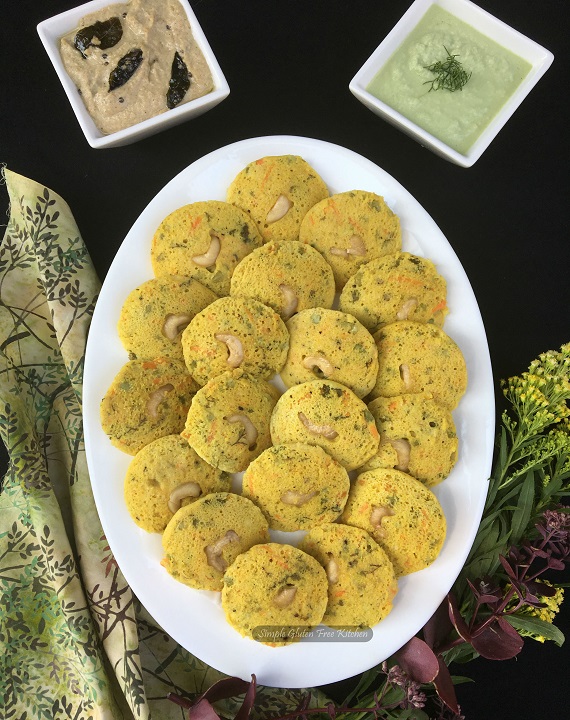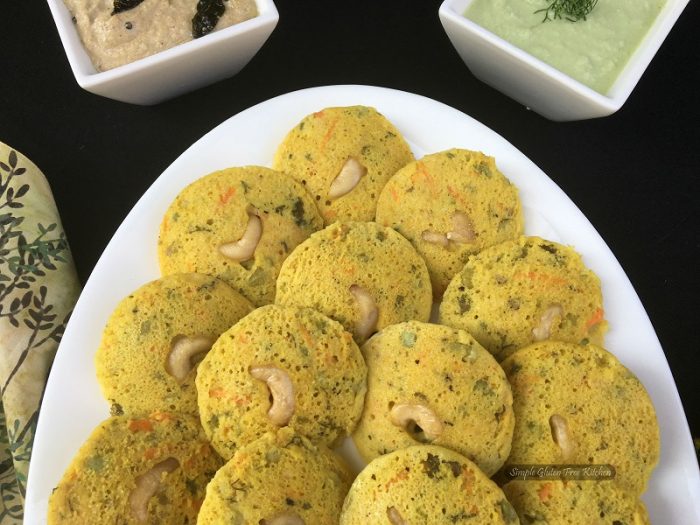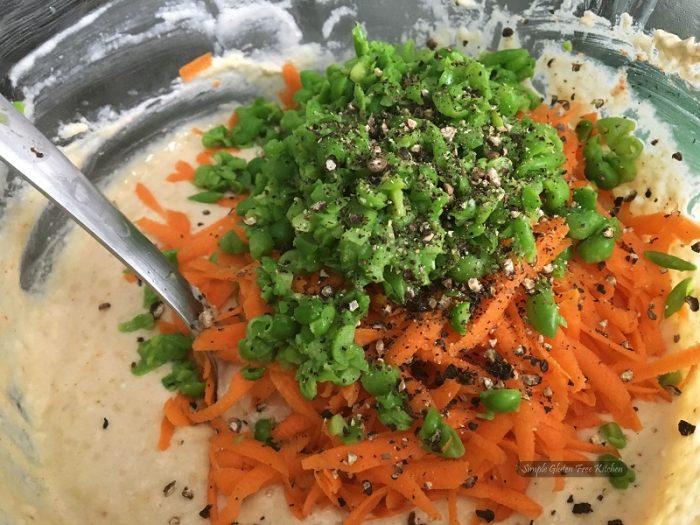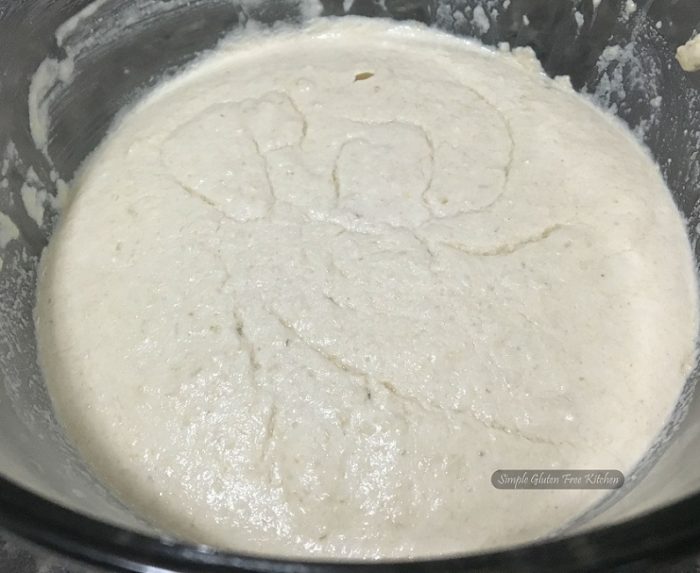Idli is perhaps one of the most famous fermented food of India, especially popular in South India. Fermented foods contain good bacteria and offers wide range of health benefits. So, I most definitely include fermented foods in the form of sauerkraut, kefir, millet crepes with sour batter, miso soup, and south indian staples like Dosa and Idli.
Idli is a filling and healthy start to the day with a combination of carbs from rice and protein from Lentils, and also for the fact that it is steamed. Idlis can also be amde with semolina, millet and oats. Infact, there are many different types of idllis. My recipe is inspired from kanchipuram idli. Kanchipuram Idli is a spiced version of regular idli from Tamilnadu. It is distributed as prashad (offering) in the temples at Kanchipuram.

The original Kanchipuram idli is steamed in bamboo baskets which are lined with mandharai leaves (Bauhinia racemosa). These leaves impart the classic flavor to the idli. These days Kanchipuram idlis are made in tumblers or a deep flat dish to differentiate it from regular idlis. It is then cut into pieces and served. One can actually eat these idlis without any accompaniment because of the flavoring from cumin, pepper, and ginger.
My recipe calls for oats, vegetables, and some additional spices. In the temple they use regular raw rice, not oats to make these idlis; vegetables are also not added. However, while making them at home one can add different flavor variations for extra boost of nutrition.

While the idlis only take about 30 mins to cook, the process of fermentation for the batter takes more than a day so you do need to plan it ahead. If the batter ferments well, the idlis will come out good. The process of fermentation is integral to the natural sourness of idli batter, that ensures soft idlis that are easy to digest.

Fermentation happens when the batter is kept in a warm place. It can take anywhere between 8 – 12 hours. If you live in a cooler climate it can take up to 15 -24 hours and one has to get creative to see what works. Here are a few things that you can do:
- Keep the batter to ferment in the oven with the lights on.
- Keep it in the boiler room for 2 hours, then tie the container in a regular plastic grocery bag and place in the oven with the oven light OFF. The batter can double in size and spill over the bowl, so make sure your bowl is large enough. (this is my preferred method for setting yogurt and fermenting batter in harsh cold conditions).
- Place the container of batter in hot water. Change the water when it gets cold.
- Wrap the container in a thermal blanket.
- If nothing works for you add 1/4 tsp baking soda and 1 tbsp lemon juice for 1 cup of idli batter just before steaming. It will help the idlis to raise well.
Once the batter ferments, the idlis are steamed in a special idli steamer. If you do not have an Idli steamer, you can use regular steamer and make idlis in silicon cups (check here) or a large pan and cut them like cake. I have also made them in the microwave before but I haven’t tested them with this batter.
While the Idlis were steaming I made sambar and two chutneys. Slightly spicy peanut chutney and mild coconut chutney are the usual accompaniments to these idlis. Sambar was not required but I made it as we were having them for lunch.

After 12 hours.
Steamed cake made from oats, vegetables, and spices for a nutritious breakfast or brunch.
Ingredients
- 1/2 cup urad daal (skinless)
- 1/2 cup steel cut oats (not instant)
- 1/2 cup yellow mung daal
- 1 tsp fenugreek seeds
- 1 cup grated carrot
- 1/2 cup green peas, coarsely grind
- 1/2 tsp turmeric powder
- 1/2 tsp cumin seeds, coarsely ground
- 1/2 tsp, ground ginger
- 1/2 tsp red chili powder
- 1/2 tsp garam masala
- 1/4 cup chopped cilantro or curry leaves
- Salt and black pepper to taste
- 24 raw cashews
- 1/8 tsp baking soda (optional)
- Oil for greasing the molds
Instructions
- Soak the steel cut oats, urad dal and mung dal separately. Add the fenugreek seeds to the urad daal. Soak overnight or a minimum of 8 hours.
- You are going to be grinding the three elements, separately to achieve the right consistency, in a blender.
- Drain the oats, mung and urad dal, reserving the water used for soaking.
- Grind urad daal by adding (drained) water little by little at regular intervals until you get a fluffy batter. Make sure there are no urad dal or fenugreek seeds sticking to the side of blender. Use a plastic spatula to remove them from the sides and grind evenly. It will be smooth and fluffy and will take a bit of time to reach that consistency.
- Remove the urad dal batter in a container.The idli batter will almost doubles in volume so choose a large container with enough space to allow the batter to ferment and expand.
- Next add the mung daal to the blender bowl (no need to wash) and grind to a smooth batter. This will be quicker than urad. Transfer mung batter to the container with urad batter.
- Similarly grind oats adding just enough water necessary, but this time aim for a slightly coarser batter as opposed to the smooth batter of the lentils.
- Transfer oats batter to the container containing lentil batter. Beat the batter using a large spoon to incorporate air into it. The batter should have the consistency of pancake batter. If it is thick add the excess drained water little by little till you get the perfect consistency. Cover the container with a lid and keep it undisturbed in a warm place for fermentation.
- After the fermentation process, add the vegetables, ginger, cumin, red chili powder, salt, pepper, and cilantro. Mix thoroughly (if the batter doesn't seem properly fermented, add baking soda and lemon juice just before steaming. It will help the idlis to rise well).
- Grease the idli molds with oil. Place cashew in each mold and spoon approximately 2 tbsp batter, allowing a little room to let the idlis rise.
- Steam them in special idli steamer or regular steamer with silicon cups for 10-15 minutes and switch off the flame.
- Remove the idli plates and allow to cool. Run a spoon under each mold, and scoop out the idlis from plates.
- Serve them hot with coconut and peanut chutney.
Notes
The proportion of daal in kanchipuram idli is more thus the idlis have a slight dense texture.
I am bringing these idlis to #cookblogshare @ a strong coffee.

Angie@Angie's Recipes
As a kid I had something quite similar for the breakfast, but just the plain one. These look and sound so good with all the veggies and wonderful spices.
Loretta
Love idlis but have never made them. I am always afraid I’d mess up, but I have bought ready made batter and tried them at home. Love how yours look and reading through the ingredients, I know I’d love the taste too. 🙂
marcie
I’ve never tried this but it looks so delicious! I love that it’s good for digestion!
Monika Dabrowski
Love savory breakfasts, this one looks really interesting and full of delicious goodness!
Monika Dabrowski
Love savory breakfasts, this one looks really interesting and full of delicious goodness!
Geetha Priyanka
Yum!!! These idlis looks so healthy and delicious. Love your creative idea of using oats and vegetables. I will try it sometime to see if my daughter likes it as she never like plain idlis. #CookBlogShare
Lathiya
These idlis looks divine..Pictures are so droolworthy
Louise Fairweather
I have never tried Idlis, but I like that they have vegetables in. #cookblogshare
Abbe@This is How I Cook
I can’t pronounce it but it looks like it tastes great! And anything fermented is so hot right now!
The Girl Next Door
Though I have been living in South India for the last few years, I don’t think I have ever had a chance to savour Kanchipuram idlis. Your version looks and sounds delicious! I’m bookmarking the recipe to try out later. 🙂